A Comprehensive Proposal for Cloud Computing Service
VerifiedAdded on 2021/06/14
|16
|3985
|56
Report
AI Summary
This research proposal outlines a new cloud computing service designed to address key challenges in corporate environments. It begins with an introduction to the service, followed by a literature review exploring existing research on cloud computing, including Infrastructure as a Service (IaaS), Platform as a Service (PaaS), and Software as a Service (SaaS) models. The methodology section details the implementation of cloud storage services, emphasizing data encryption and knowledge management. The proposal highlights the benefits for organizations, such as improved data management and streamlined processes, and concludes with a discussion of anticipated outcomes. The document also touches upon the advantages of cloud computing, including scalability, security, and cost-effectiveness compared to traditional methods. The report also discusses the challenges of adopting cloud computing, such as data migration and integration, and offers solutions to overcome them.
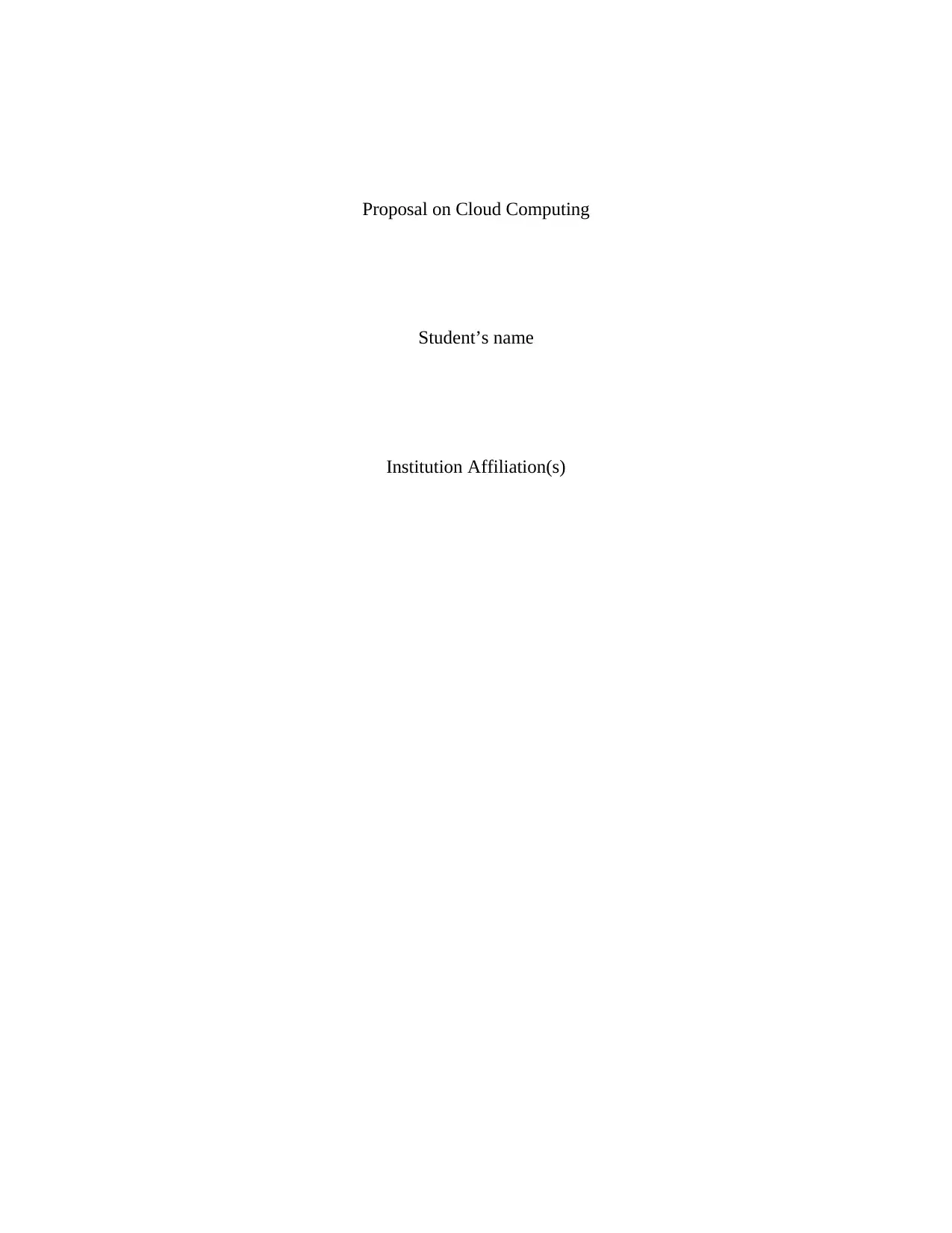
Proposal on Cloud Computing
Student’s name
Institution Affiliation(s)
Student’s name
Institution Affiliation(s)
Paraphrase This Document
Need a fresh take? Get an instant paraphrase of this document with our AI Paraphraser
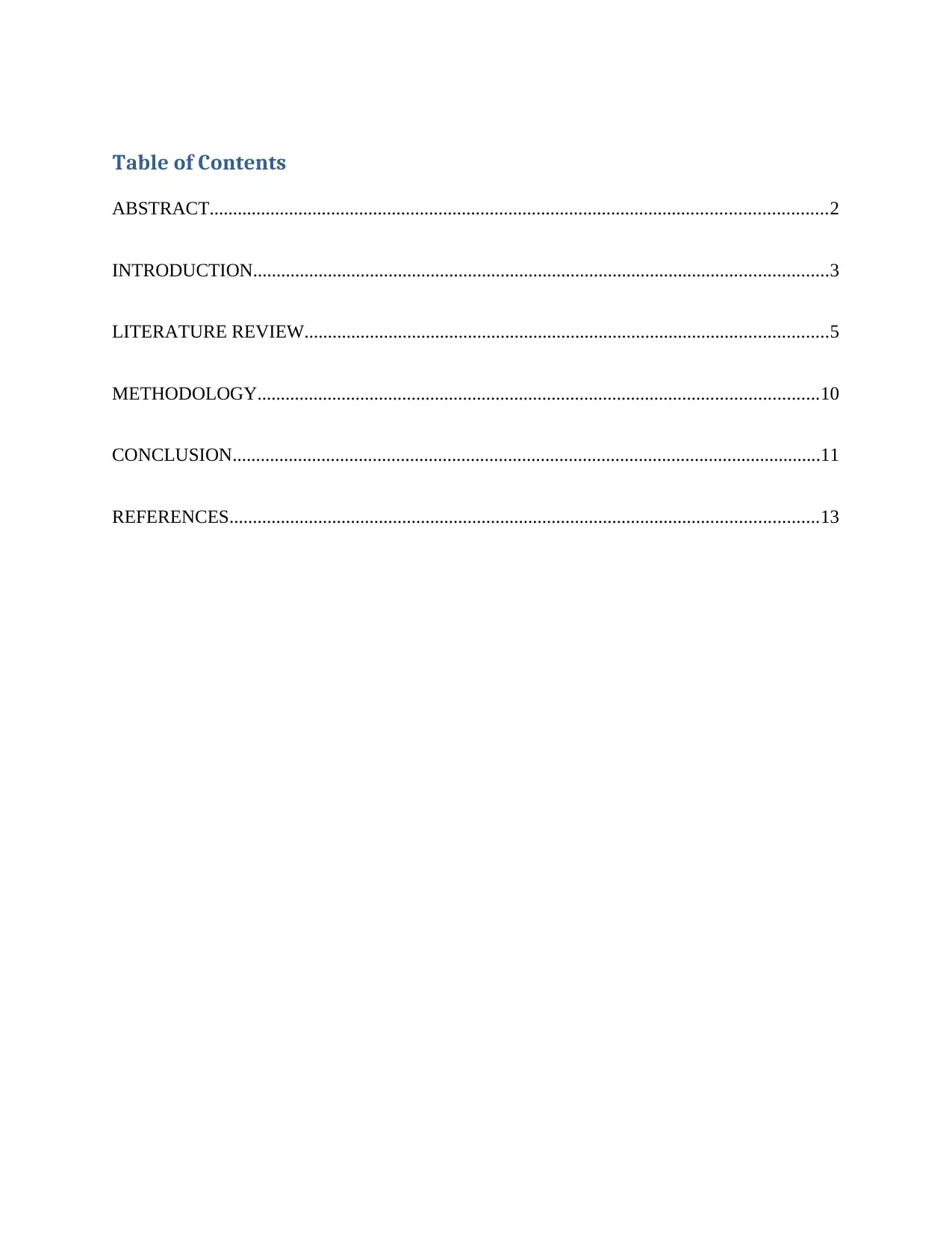
Table of Contents
ABSTRACT....................................................................................................................................2
INTRODUCTION...........................................................................................................................3
LITERATURE REVIEW................................................................................................................5
METHODOLOGY........................................................................................................................10
CONCLUSION..............................................................................................................................11
REFERENCES..............................................................................................................................13
ABSTRACT....................................................................................................................................2
INTRODUCTION...........................................................................................................................3
LITERATURE REVIEW................................................................................................................5
METHODOLOGY........................................................................................................................10
CONCLUSION..............................................................................................................................11
REFERENCES..............................................................................................................................13
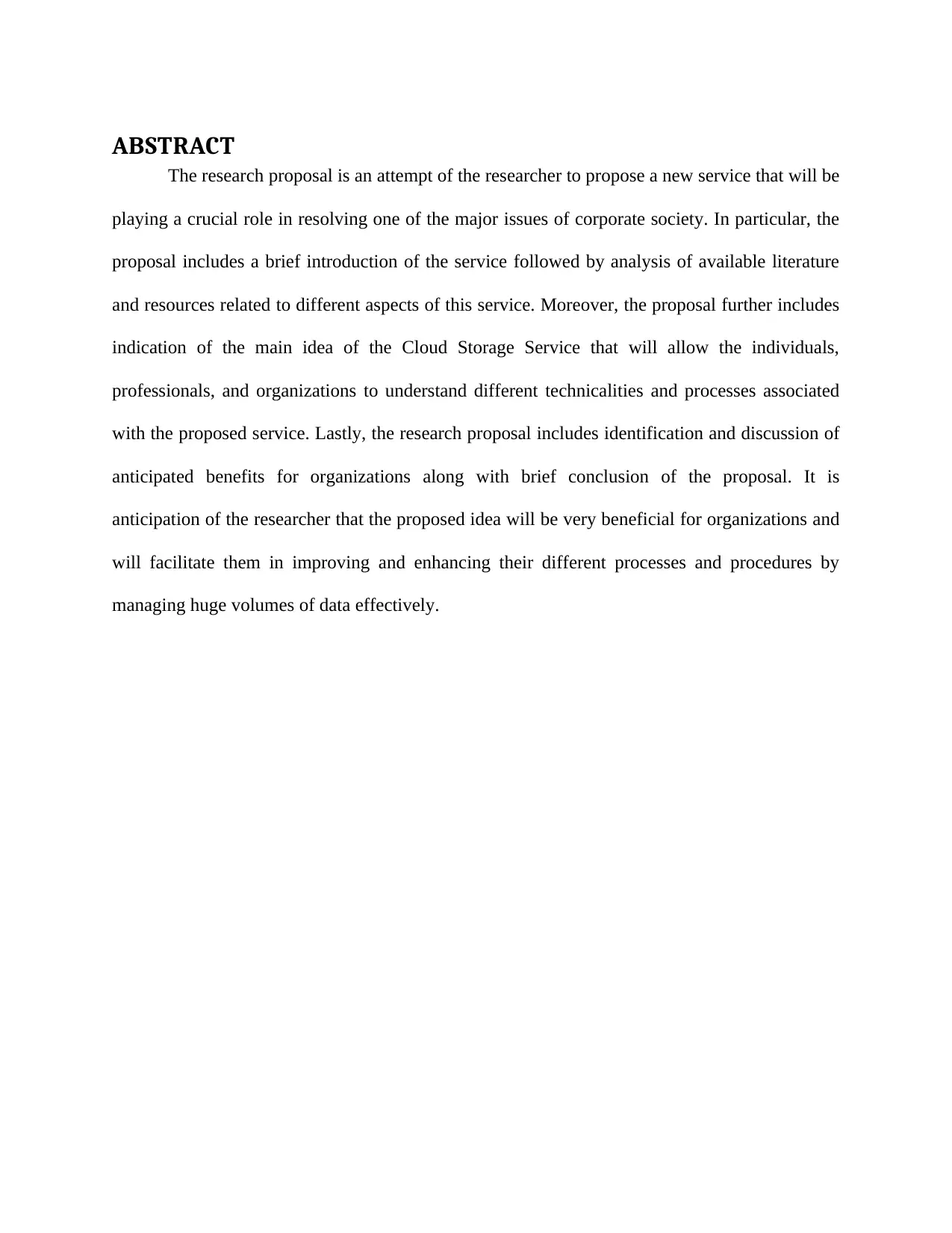
ABSTRACT
The research proposal is an attempt of the researcher to propose a new service that will be
playing a crucial role in resolving one of the major issues of corporate society. In particular, the
proposal includes a brief introduction of the service followed by analysis of available literature
and resources related to different aspects of this service. Moreover, the proposal further includes
indication of the main idea of the Cloud Storage Service that will allow the individuals,
professionals, and organizations to understand different technicalities and processes associated
with the proposed service. Lastly, the research proposal includes identification and discussion of
anticipated benefits for organizations along with brief conclusion of the proposal. It is
anticipation of the researcher that the proposed idea will be very beneficial for organizations and
will facilitate them in improving and enhancing their different processes and procedures by
managing huge volumes of data effectively.
The research proposal is an attempt of the researcher to propose a new service that will be
playing a crucial role in resolving one of the major issues of corporate society. In particular, the
proposal includes a brief introduction of the service followed by analysis of available literature
and resources related to different aspects of this service. Moreover, the proposal further includes
indication of the main idea of the Cloud Storage Service that will allow the individuals,
professionals, and organizations to understand different technicalities and processes associated
with the proposed service. Lastly, the research proposal includes identification and discussion of
anticipated benefits for organizations along with brief conclusion of the proposal. It is
anticipation of the researcher that the proposed idea will be very beneficial for organizations and
will facilitate them in improving and enhancing their different processes and procedures by
managing huge volumes of data effectively.
⊘ This is a preview!⊘
Do you want full access?
Subscribe today to unlock all pages.

Trusted by 1+ million students worldwide
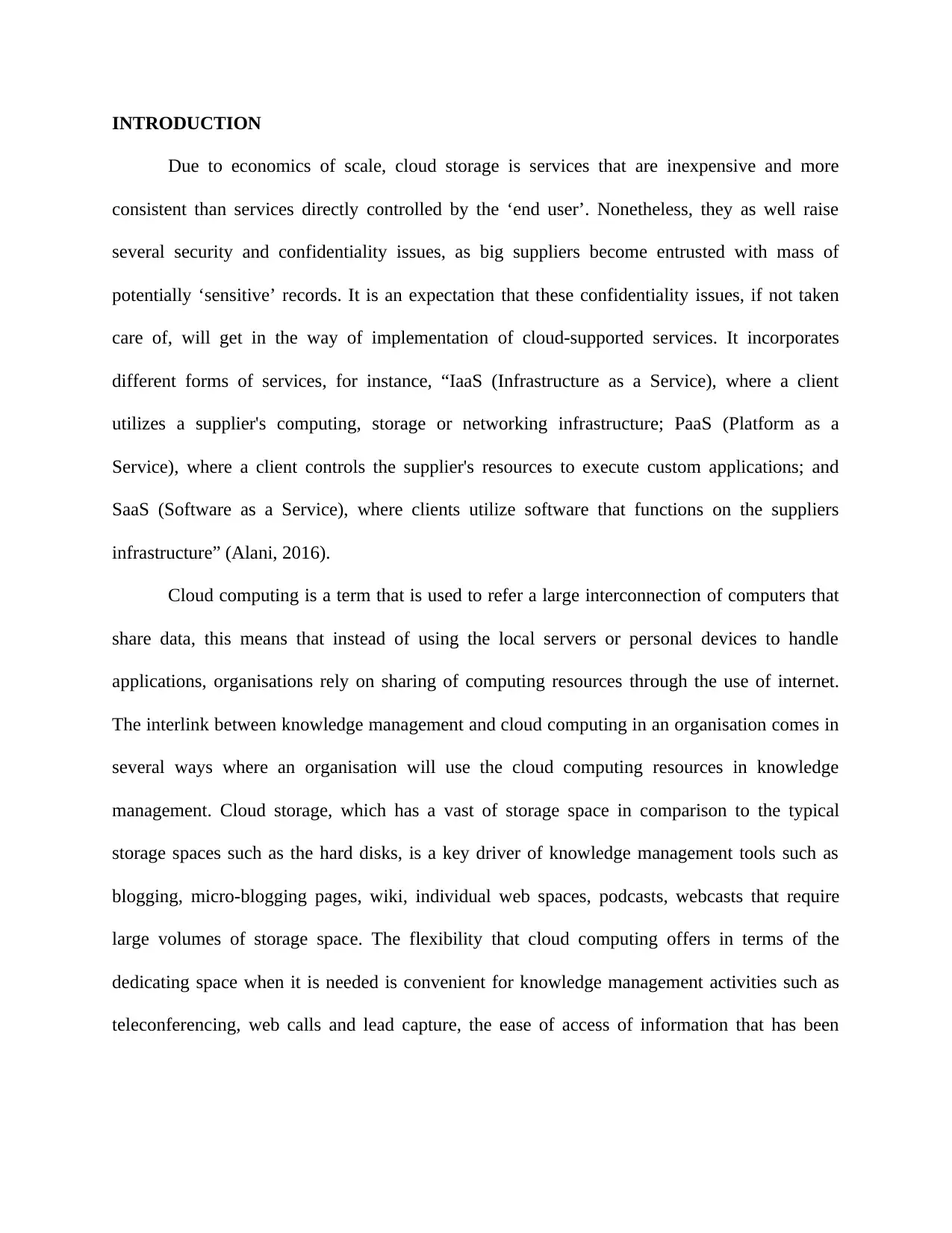
INTRODUCTION
Due to economics of scale, cloud storage is services that are inexpensive and more
consistent than services directly controlled by the ‘end user’. Nonetheless, they as well raise
several security and confidentiality issues, as big suppliers become entrusted with mass of
potentially ‘sensitive’ records. It is an expectation that these confidentiality issues, if not taken
care of, will get in the way of implementation of cloud-supported services. It incorporates
different forms of services, for instance, “IaaS (Infrastructure as a Service), where a client
utilizes a supplier's computing, storage or networking infrastructure; PaaS (Platform as a
Service), where a client controls the supplier's resources to execute custom applications; and
SaaS (Software as a Service), where clients utilize software that functions on the suppliers
infrastructure” (Alani, 2016).
Cloud computing is a term that is used to refer a large interconnection of computers that
share data, this means that instead of using the local servers or personal devices to handle
applications, organisations rely on sharing of computing resources through the use of internet.
The interlink between knowledge management and cloud computing in an organisation comes in
several ways where an organisation will use the cloud computing resources in knowledge
management. Cloud storage, which has a vast of storage space in comparison to the typical
storage spaces such as the hard disks, is a key driver of knowledge management tools such as
blogging, micro-blogging pages, wiki, individual web spaces, podcasts, webcasts that require
large volumes of storage space. The flexibility that cloud computing offers in terms of the
dedicating space when it is needed is convenient for knowledge management activities such as
teleconferencing, web calls and lead capture, the ease of access of information that has been
Due to economics of scale, cloud storage is services that are inexpensive and more
consistent than services directly controlled by the ‘end user’. Nonetheless, they as well raise
several security and confidentiality issues, as big suppliers become entrusted with mass of
potentially ‘sensitive’ records. It is an expectation that these confidentiality issues, if not taken
care of, will get in the way of implementation of cloud-supported services. It incorporates
different forms of services, for instance, “IaaS (Infrastructure as a Service), where a client
utilizes a supplier's computing, storage or networking infrastructure; PaaS (Platform as a
Service), where a client controls the supplier's resources to execute custom applications; and
SaaS (Software as a Service), where clients utilize software that functions on the suppliers
infrastructure” (Alani, 2016).
Cloud computing is a term that is used to refer a large interconnection of computers that
share data, this means that instead of using the local servers or personal devices to handle
applications, organisations rely on sharing of computing resources through the use of internet.
The interlink between knowledge management and cloud computing in an organisation comes in
several ways where an organisation will use the cloud computing resources in knowledge
management. Cloud storage, which has a vast of storage space in comparison to the typical
storage spaces such as the hard disks, is a key driver of knowledge management tools such as
blogging, micro-blogging pages, wiki, individual web spaces, podcasts, webcasts that require
large volumes of storage space. The flexibility that cloud computing offers in terms of the
dedicating space when it is needed is convenient for knowledge management activities such as
teleconferencing, web calls and lead capture, the ease of access of information that has been
Paraphrase This Document
Need a fresh take? Get an instant paraphrase of this document with our AI Paraphraser
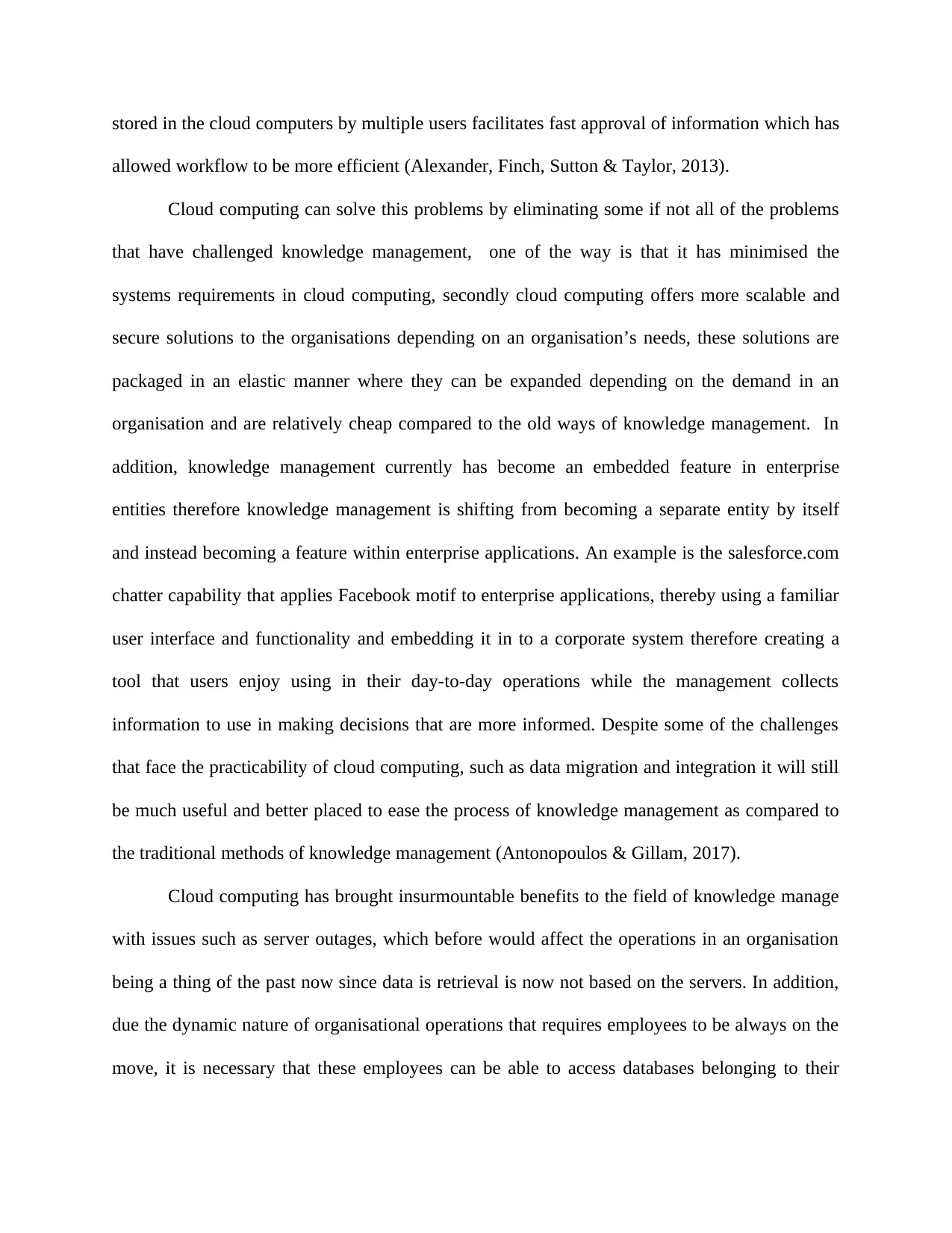
stored in the cloud computers by multiple users facilitates fast approval of information which has
allowed workflow to be more efficient (Alexander, Finch, Sutton & Taylor, 2013).
Cloud computing can solve this problems by eliminating some if not all of the problems
that have challenged knowledge management, one of the way is that it has minimised the
systems requirements in cloud computing, secondly cloud computing offers more scalable and
secure solutions to the organisations depending on an organisation’s needs, these solutions are
packaged in an elastic manner where they can be expanded depending on the demand in an
organisation and are relatively cheap compared to the old ways of knowledge management. In
addition, knowledge management currently has become an embedded feature in enterprise
entities therefore knowledge management is shifting from becoming a separate entity by itself
and instead becoming a feature within enterprise applications. An example is the salesforce.com
chatter capability that applies Facebook motif to enterprise applications, thereby using a familiar
user interface and functionality and embedding it in to a corporate system therefore creating a
tool that users enjoy using in their day-to-day operations while the management collects
information to use in making decisions that are more informed. Despite some of the challenges
that face the practicability of cloud computing, such as data migration and integration it will still
be much useful and better placed to ease the process of knowledge management as compared to
the traditional methods of knowledge management (Antonopoulos & Gillam, 2017).
Cloud computing has brought insurmountable benefits to the field of knowledge manage
with issues such as server outages, which before would affect the operations in an organisation
being a thing of the past now since data is retrieval is now not based on the servers. In addition,
due the dynamic nature of organisational operations that requires employees to be always on the
move, it is necessary that these employees can be able to access databases belonging to their
allowed workflow to be more efficient (Alexander, Finch, Sutton & Taylor, 2013).
Cloud computing can solve this problems by eliminating some if not all of the problems
that have challenged knowledge management, one of the way is that it has minimised the
systems requirements in cloud computing, secondly cloud computing offers more scalable and
secure solutions to the organisations depending on an organisation’s needs, these solutions are
packaged in an elastic manner where they can be expanded depending on the demand in an
organisation and are relatively cheap compared to the old ways of knowledge management. In
addition, knowledge management currently has become an embedded feature in enterprise
entities therefore knowledge management is shifting from becoming a separate entity by itself
and instead becoming a feature within enterprise applications. An example is the salesforce.com
chatter capability that applies Facebook motif to enterprise applications, thereby using a familiar
user interface and functionality and embedding it in to a corporate system therefore creating a
tool that users enjoy using in their day-to-day operations while the management collects
information to use in making decisions that are more informed. Despite some of the challenges
that face the practicability of cloud computing, such as data migration and integration it will still
be much useful and better placed to ease the process of knowledge management as compared to
the traditional methods of knowledge management (Antonopoulos & Gillam, 2017).
Cloud computing has brought insurmountable benefits to the field of knowledge manage
with issues such as server outages, which before would affect the operations in an organisation
being a thing of the past now since data is retrieval is now not based on the servers. In addition,
due the dynamic nature of organisational operations that requires employees to be always on the
move, it is necessary that these employees can be able to access databases belonging to their
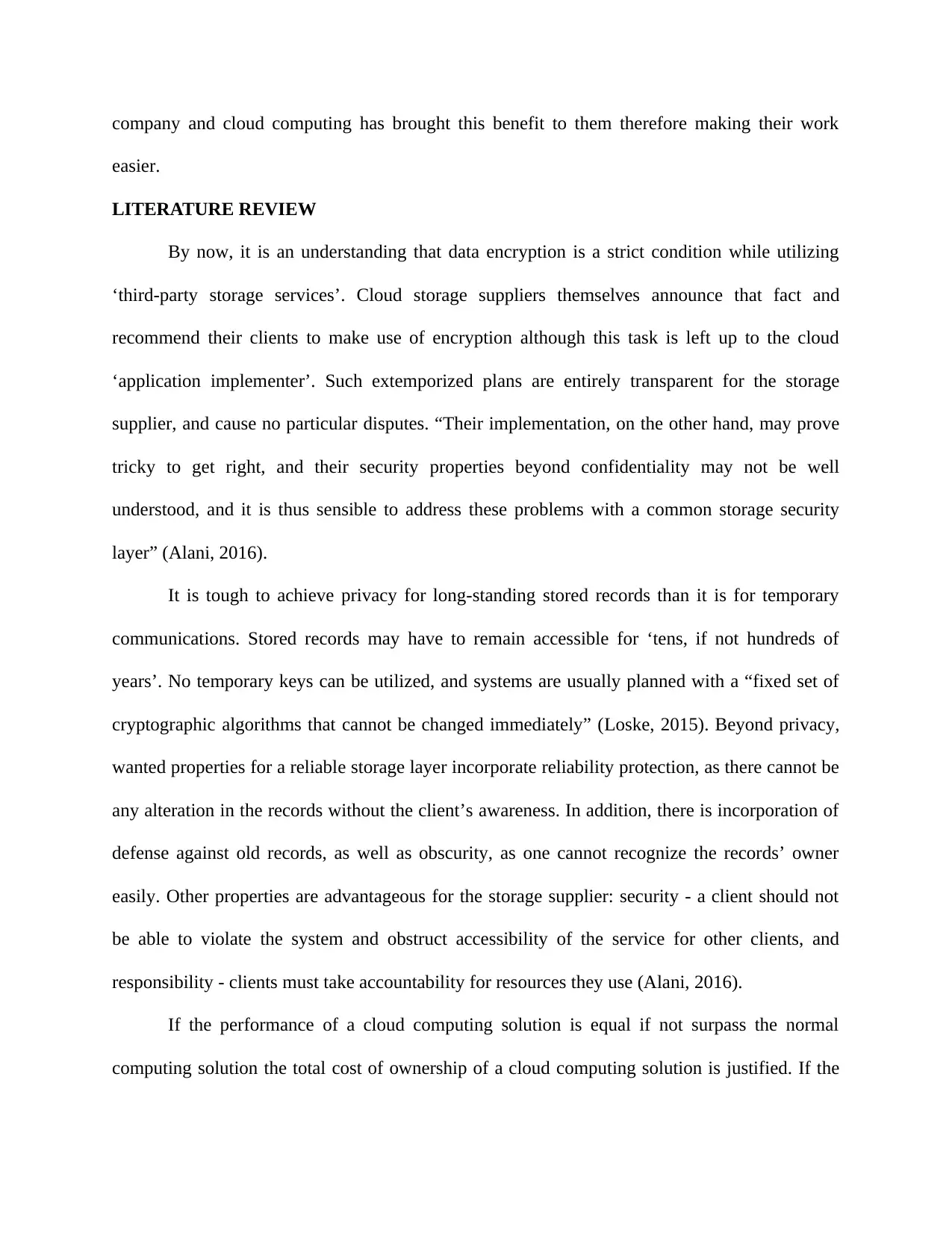
company and cloud computing has brought this benefit to them therefore making their work
easier.
LITERATURE REVIEW
By now, it is an understanding that data encryption is a strict condition while utilizing
‘third-party storage services’. Cloud storage suppliers themselves announce that fact and
recommend their clients to make use of encryption although this task is left up to the cloud
‘application implementer’. Such extemporized plans are entirely transparent for the storage
supplier, and cause no particular disputes. “Their implementation, on the other hand, may prove
tricky to get right, and their security properties beyond confidentiality may not be well
understood, and it is thus sensible to address these problems with a common storage security
layer” (Alani, 2016).
It is tough to achieve privacy for long-standing stored records than it is for temporary
communications. Stored records may have to remain accessible for ‘tens, if not hundreds of
years’. No temporary keys can be utilized, and systems are usually planned with a “fixed set of
cryptographic algorithms that cannot be changed immediately” (Loske, 2015). Beyond privacy,
wanted properties for a reliable storage layer incorporate reliability protection, as there cannot be
any alteration in the records without the client’s awareness. In addition, there is incorporation of
defense against old records, as well as obscurity, as one cannot recognize the records’ owner
easily. Other properties are advantageous for the storage supplier: security - a client should not
be able to violate the system and obstruct accessibility of the service for other clients, and
responsibility - clients must take accountability for resources they use (Alani, 2016).
If the performance of a cloud computing solution is equal if not surpass the normal
computing solution the total cost of ownership of a cloud computing solution is justified. If the
easier.
LITERATURE REVIEW
By now, it is an understanding that data encryption is a strict condition while utilizing
‘third-party storage services’. Cloud storage suppliers themselves announce that fact and
recommend their clients to make use of encryption although this task is left up to the cloud
‘application implementer’. Such extemporized plans are entirely transparent for the storage
supplier, and cause no particular disputes. “Their implementation, on the other hand, may prove
tricky to get right, and their security properties beyond confidentiality may not be well
understood, and it is thus sensible to address these problems with a common storage security
layer” (Alani, 2016).
It is tough to achieve privacy for long-standing stored records than it is for temporary
communications. Stored records may have to remain accessible for ‘tens, if not hundreds of
years’. No temporary keys can be utilized, and systems are usually planned with a “fixed set of
cryptographic algorithms that cannot be changed immediately” (Loske, 2015). Beyond privacy,
wanted properties for a reliable storage layer incorporate reliability protection, as there cannot be
any alteration in the records without the client’s awareness. In addition, there is incorporation of
defense against old records, as well as obscurity, as one cannot recognize the records’ owner
easily. Other properties are advantageous for the storage supplier: security - a client should not
be able to violate the system and obstruct accessibility of the service for other clients, and
responsibility - clients must take accountability for resources they use (Alani, 2016).
If the performance of a cloud computing solution is equal if not surpass the normal
computing solution the total cost of ownership of a cloud computing solution is justified. If the
⊘ This is a preview!⊘
Do you want full access?
Subscribe today to unlock all pages.

Trusted by 1+ million students worldwide
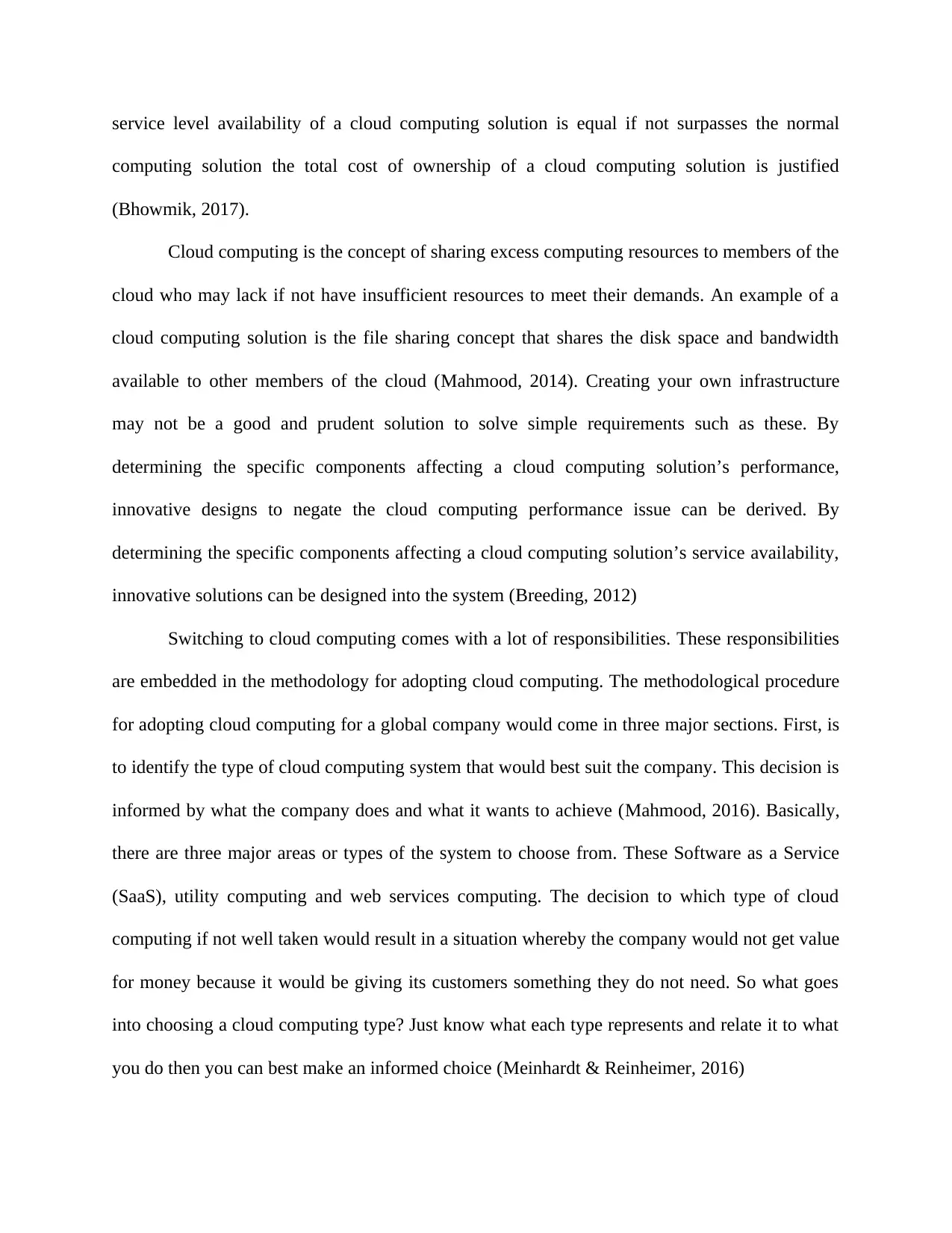
service level availability of a cloud computing solution is equal if not surpasses the normal
computing solution the total cost of ownership of a cloud computing solution is justified
(Bhowmik, 2017).
Cloud computing is the concept of sharing excess computing resources to members of the
cloud who may lack if not have insufficient resources to meet their demands. An example of a
cloud computing solution is the file sharing concept that shares the disk space and bandwidth
available to other members of the cloud (Mahmood, 2014). Creating your own infrastructure
may not be a good and prudent solution to solve simple requirements such as these. By
determining the specific components affecting a cloud computing solution’s performance,
innovative designs to negate the cloud computing performance issue can be derived. By
determining the specific components affecting a cloud computing solution’s service availability,
innovative solutions can be designed into the system (Breeding, 2012)
Switching to cloud computing comes with a lot of responsibilities. These responsibilities
are embedded in the methodology for adopting cloud computing. The methodological procedure
for adopting cloud computing for a global company would come in three major sections. First, is
to identify the type of cloud computing system that would best suit the company. This decision is
informed by what the company does and what it wants to achieve (Mahmood, 2016). Basically,
there are three major areas or types of the system to choose from. These Software as a Service
(SaaS), utility computing and web services computing. The decision to which type of cloud
computing if not well taken would result in a situation whereby the company would not get value
for money because it would be giving its customers something they do not need. So what goes
into choosing a cloud computing type? Just know what each type represents and relate it to what
you do then you can best make an informed choice (Meinhardt & Reinheimer, 2016)
computing solution the total cost of ownership of a cloud computing solution is justified
(Bhowmik, 2017).
Cloud computing is the concept of sharing excess computing resources to members of the
cloud who may lack if not have insufficient resources to meet their demands. An example of a
cloud computing solution is the file sharing concept that shares the disk space and bandwidth
available to other members of the cloud (Mahmood, 2014). Creating your own infrastructure
may not be a good and prudent solution to solve simple requirements such as these. By
determining the specific components affecting a cloud computing solution’s performance,
innovative designs to negate the cloud computing performance issue can be derived. By
determining the specific components affecting a cloud computing solution’s service availability,
innovative solutions can be designed into the system (Breeding, 2012)
Switching to cloud computing comes with a lot of responsibilities. These responsibilities
are embedded in the methodology for adopting cloud computing. The methodological procedure
for adopting cloud computing for a global company would come in three major sections. First, is
to identify the type of cloud computing system that would best suit the company. This decision is
informed by what the company does and what it wants to achieve (Mahmood, 2016). Basically,
there are three major areas or types of the system to choose from. These Software as a Service
(SaaS), utility computing and web services computing. The decision to which type of cloud
computing if not well taken would result in a situation whereby the company would not get value
for money because it would be giving its customers something they do not need. So what goes
into choosing a cloud computing type? Just know what each type represents and relate it to what
you do then you can best make an informed choice (Meinhardt & Reinheimer, 2016)
Paraphrase This Document
Need a fresh take? Get an instant paraphrase of this document with our AI Paraphraser
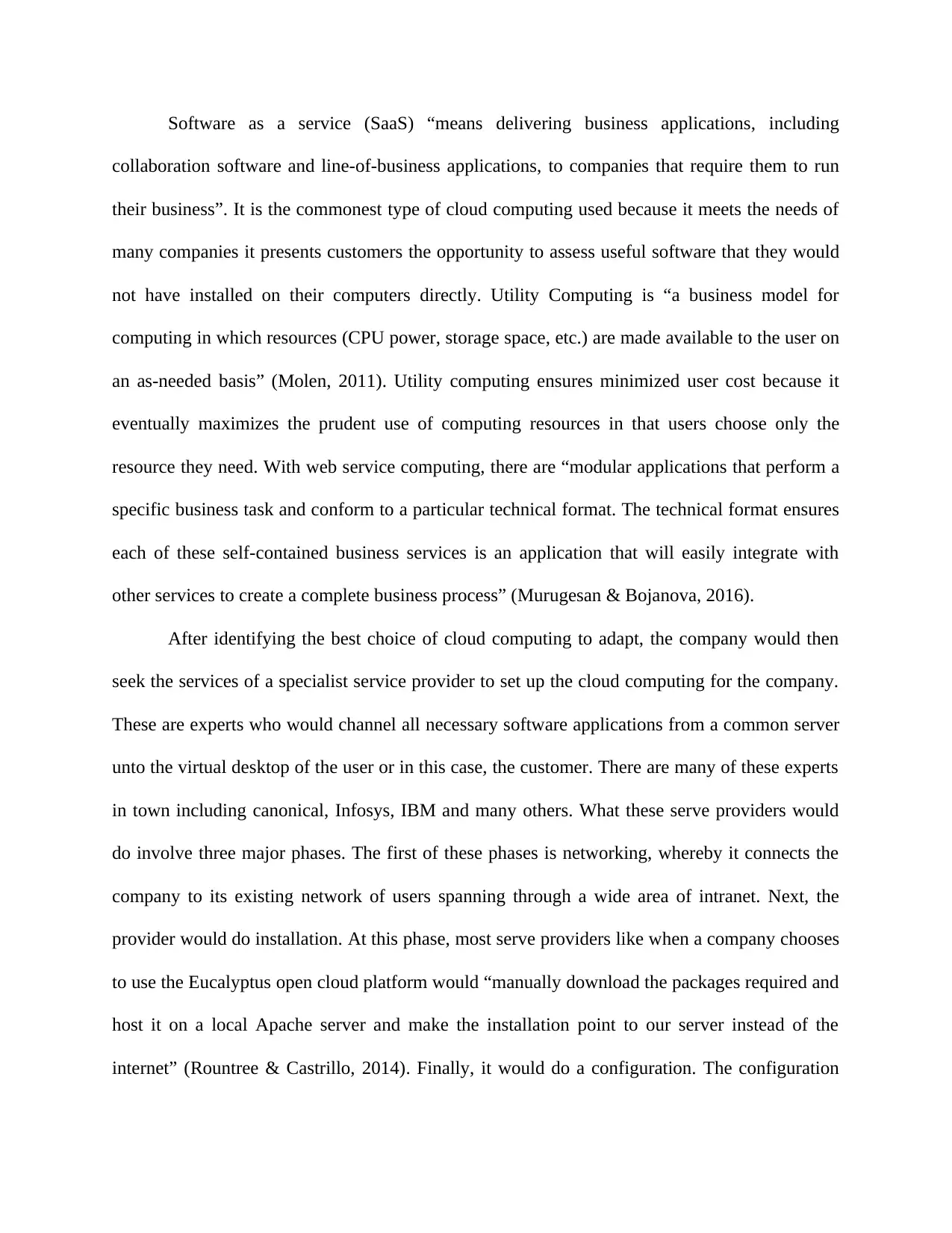
Software as a service (SaaS) “means delivering business applications, including
collaboration software and line-of-business applications, to companies that require them to run
their business”. It is the commonest type of cloud computing used because it meets the needs of
many companies it presents customers the opportunity to assess useful software that they would
not have installed on their computers directly. Utility Computing is “a business model for
computing in which resources (CPU power, storage space, etc.) are made available to the user on
an as-needed basis” (Molen, 2011). Utility computing ensures minimized user cost because it
eventually maximizes the prudent use of computing resources in that users choose only the
resource they need. With web service computing, there are “modular applications that perform a
specific business task and conform to a particular technical format. The technical format ensures
each of these self-contained business services is an application that will easily integrate with
other services to create a complete business process” (Murugesan & Bojanova, 2016).
After identifying the best choice of cloud computing to adapt, the company would then
seek the services of a specialist service provider to set up the cloud computing for the company.
These are experts who would channel all necessary software applications from a common server
unto the virtual desktop of the user or in this case, the customer. There are many of these experts
in town including canonical, Infosys, IBM and many others. What these serve providers would
do involve three major phases. The first of these phases is networking, whereby it connects the
company to its existing network of users spanning through a wide area of intranet. Next, the
provider would do installation. At this phase, most serve providers like when a company chooses
to use the Eucalyptus open cloud platform would “manually download the packages required and
host it on a local Apache server and make the installation point to our server instead of the
internet” (Rountree & Castrillo, 2014). Finally, it would do a configuration. The configuration
collaboration software and line-of-business applications, to companies that require them to run
their business”. It is the commonest type of cloud computing used because it meets the needs of
many companies it presents customers the opportunity to assess useful software that they would
not have installed on their computers directly. Utility Computing is “a business model for
computing in which resources (CPU power, storage space, etc.) are made available to the user on
an as-needed basis” (Molen, 2011). Utility computing ensures minimized user cost because it
eventually maximizes the prudent use of computing resources in that users choose only the
resource they need. With web service computing, there are “modular applications that perform a
specific business task and conform to a particular technical format. The technical format ensures
each of these self-contained business services is an application that will easily integrate with
other services to create a complete business process” (Murugesan & Bojanova, 2016).
After identifying the best choice of cloud computing to adapt, the company would then
seek the services of a specialist service provider to set up the cloud computing for the company.
These are experts who would channel all necessary software applications from a common server
unto the virtual desktop of the user or in this case, the customer. There are many of these experts
in town including canonical, Infosys, IBM and many others. What these serve providers would
do involve three major phases. The first of these phases is networking, whereby it connects the
company to its existing network of users spanning through a wide area of intranet. Next, the
provider would do installation. At this phase, most serve providers like when a company chooses
to use the Eucalyptus open cloud platform would “manually download the packages required and
host it on a local Apache server and make the installation point to our server instead of the
internet” (Rountree & Castrillo, 2014). Finally, it would do a configuration. The configuration
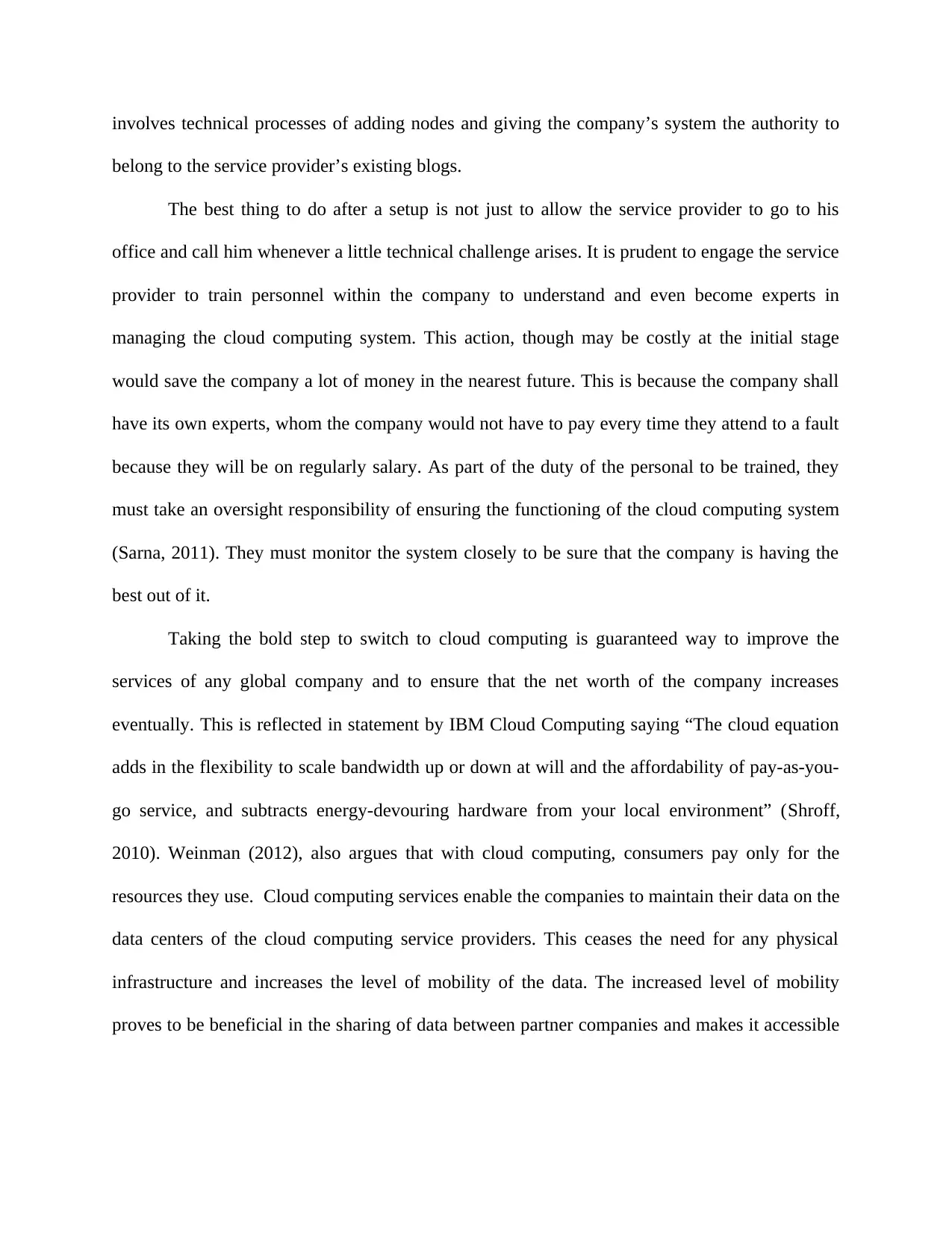
involves technical processes of adding nodes and giving the company’s system the authority to
belong to the service provider’s existing blogs.
The best thing to do after a setup is not just to allow the service provider to go to his
office and call him whenever a little technical challenge arises. It is prudent to engage the service
provider to train personnel within the company to understand and even become experts in
managing the cloud computing system. This action, though may be costly at the initial stage
would save the company a lot of money in the nearest future. This is because the company shall
have its own experts, whom the company would not have to pay every time they attend to a fault
because they will be on regularly salary. As part of the duty of the personal to be trained, they
must take an oversight responsibility of ensuring the functioning of the cloud computing system
(Sarna, 2011). They must monitor the system closely to be sure that the company is having the
best out of it.
Taking the bold step to switch to cloud computing is guaranteed way to improve the
services of any global company and to ensure that the net worth of the company increases
eventually. This is reflected in statement by IBM Cloud Computing saying “The cloud equation
adds in the flexibility to scale bandwidth up or down at will and the affordability of pay-as-you-
go service, and subtracts energy-devouring hardware from your local environment” (Shroff,
2010). Weinman (2012), also argues that with cloud computing, consumers pay only for the
resources they use. Cloud computing services enable the companies to maintain their data on the
data centers of the cloud computing service providers. This ceases the need for any physical
infrastructure and increases the level of mobility of the data. The increased level of mobility
proves to be beneficial in the sharing of data between partner companies and makes it accessible
belong to the service provider’s existing blogs.
The best thing to do after a setup is not just to allow the service provider to go to his
office and call him whenever a little technical challenge arises. It is prudent to engage the service
provider to train personnel within the company to understand and even become experts in
managing the cloud computing system. This action, though may be costly at the initial stage
would save the company a lot of money in the nearest future. This is because the company shall
have its own experts, whom the company would not have to pay every time they attend to a fault
because they will be on regularly salary. As part of the duty of the personal to be trained, they
must take an oversight responsibility of ensuring the functioning of the cloud computing system
(Sarna, 2011). They must monitor the system closely to be sure that the company is having the
best out of it.
Taking the bold step to switch to cloud computing is guaranteed way to improve the
services of any global company and to ensure that the net worth of the company increases
eventually. This is reflected in statement by IBM Cloud Computing saying “The cloud equation
adds in the flexibility to scale bandwidth up or down at will and the affordability of pay-as-you-
go service, and subtracts energy-devouring hardware from your local environment” (Shroff,
2010). Weinman (2012), also argues that with cloud computing, consumers pay only for the
resources they use. Cloud computing services enable the companies to maintain their data on the
data centers of the cloud computing service providers. This ceases the need for any physical
infrastructure and increases the level of mobility of the data. The increased level of mobility
proves to be beneficial in the sharing of data between partner companies and makes it accessible
⊘ This is a preview!⊘
Do you want full access?
Subscribe today to unlock all pages.

Trusted by 1+ million students worldwide
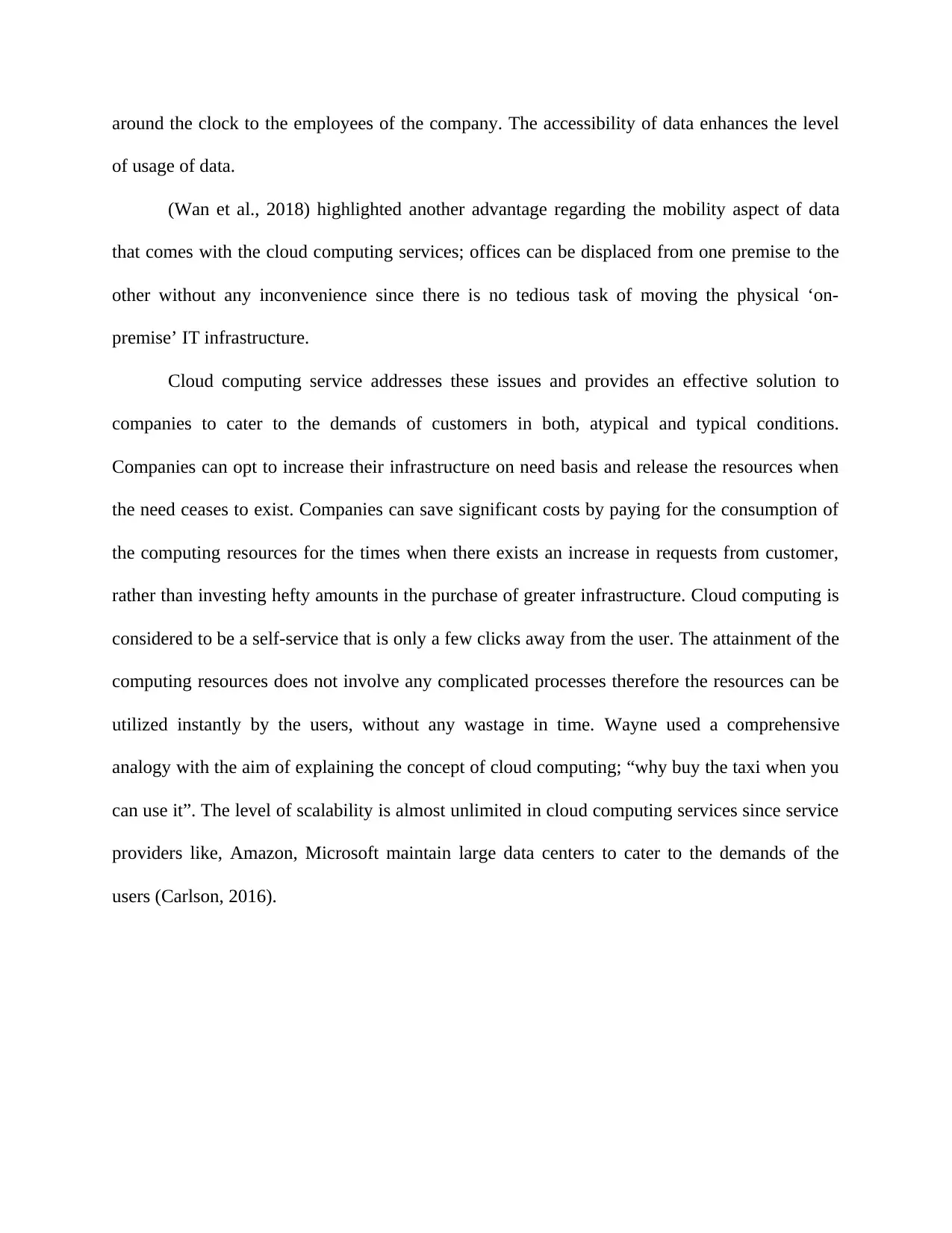
around the clock to the employees of the company. The accessibility of data enhances the level
of usage of data.
(Wan et al., 2018) highlighted another advantage regarding the mobility aspect of data
that comes with the cloud computing services; offices can be displaced from one premise to the
other without any inconvenience since there is no tedious task of moving the physical ‘on-
premise’ IT infrastructure.
Cloud computing service addresses these issues and provides an effective solution to
companies to cater to the demands of customers in both, atypical and typical conditions.
Companies can opt to increase their infrastructure on need basis and release the resources when
the need ceases to exist. Companies can save significant costs by paying for the consumption of
the computing resources for the times when there exists an increase in requests from customer,
rather than investing hefty amounts in the purchase of greater infrastructure. Cloud computing is
considered to be a self-service that is only a few clicks away from the user. The attainment of the
computing resources does not involve any complicated processes therefore the resources can be
utilized instantly by the users, without any wastage in time. Wayne used a comprehensive
analogy with the aim of explaining the concept of cloud computing; “why buy the taxi when you
can use it”. The level of scalability is almost unlimited in cloud computing services since service
providers like, Amazon, Microsoft maintain large data centers to cater to the demands of the
users (Carlson, 2016).
of usage of data.
(Wan et al., 2018) highlighted another advantage regarding the mobility aspect of data
that comes with the cloud computing services; offices can be displaced from one premise to the
other without any inconvenience since there is no tedious task of moving the physical ‘on-
premise’ IT infrastructure.
Cloud computing service addresses these issues and provides an effective solution to
companies to cater to the demands of customers in both, atypical and typical conditions.
Companies can opt to increase their infrastructure on need basis and release the resources when
the need ceases to exist. Companies can save significant costs by paying for the consumption of
the computing resources for the times when there exists an increase in requests from customer,
rather than investing hefty amounts in the purchase of greater infrastructure. Cloud computing is
considered to be a self-service that is only a few clicks away from the user. The attainment of the
computing resources does not involve any complicated processes therefore the resources can be
utilized instantly by the users, without any wastage in time. Wayne used a comprehensive
analogy with the aim of explaining the concept of cloud computing; “why buy the taxi when you
can use it”. The level of scalability is almost unlimited in cloud computing services since service
providers like, Amazon, Microsoft maintain large data centers to cater to the demands of the
users (Carlson, 2016).
Paraphrase This Document
Need a fresh take? Get an instant paraphrase of this document with our AI Paraphraser
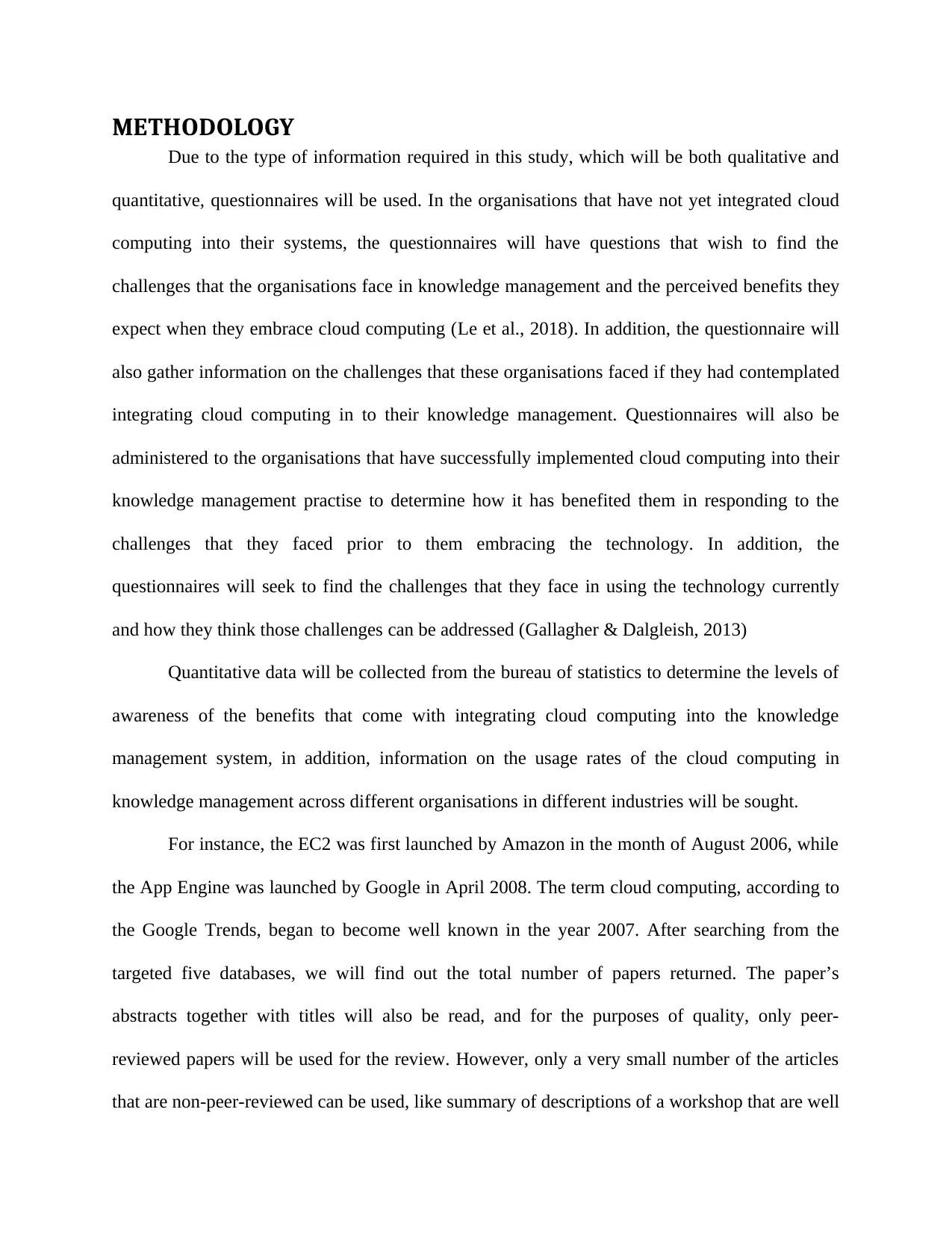
METHODOLOGY
Due to the type of information required in this study, which will be both qualitative and
quantitative, questionnaires will be used. In the organisations that have not yet integrated cloud
computing into their systems, the questionnaires will have questions that wish to find the
challenges that the organisations face in knowledge management and the perceived benefits they
expect when they embrace cloud computing (Le et al., 2018). In addition, the questionnaire will
also gather information on the challenges that these organisations faced if they had contemplated
integrating cloud computing in to their knowledge management. Questionnaires will also be
administered to the organisations that have successfully implemented cloud computing into their
knowledge management practise to determine how it has benefited them in responding to the
challenges that they faced prior to them embracing the technology. In addition, the
questionnaires will seek to find the challenges that they face in using the technology currently
and how they think those challenges can be addressed (Gallagher & Dalgleish, 2013)
Quantitative data will be collected from the bureau of statistics to determine the levels of
awareness of the benefits that come with integrating cloud computing into the knowledge
management system, in addition, information on the usage rates of the cloud computing in
knowledge management across different organisations in different industries will be sought.
For instance, the EC2 was first launched by Amazon in the month of August 2006, while
the App Engine was launched by Google in April 2008. The term cloud computing, according to
the Google Trends, began to become well known in the year 2007. After searching from the
targeted five databases, we will find out the total number of papers returned. The paper’s
abstracts together with titles will also be read, and for the purposes of quality, only peer-
reviewed papers will be used for the review. However, only a very small number of the articles
that are non-peer-reviewed can be used, like summary of descriptions of a workshop that are well
Due to the type of information required in this study, which will be both qualitative and
quantitative, questionnaires will be used. In the organisations that have not yet integrated cloud
computing into their systems, the questionnaires will have questions that wish to find the
challenges that the organisations face in knowledge management and the perceived benefits they
expect when they embrace cloud computing (Le et al., 2018). In addition, the questionnaire will
also gather information on the challenges that these organisations faced if they had contemplated
integrating cloud computing in to their knowledge management. Questionnaires will also be
administered to the organisations that have successfully implemented cloud computing into their
knowledge management practise to determine how it has benefited them in responding to the
challenges that they faced prior to them embracing the technology. In addition, the
questionnaires will seek to find the challenges that they face in using the technology currently
and how they think those challenges can be addressed (Gallagher & Dalgleish, 2013)
Quantitative data will be collected from the bureau of statistics to determine the levels of
awareness of the benefits that come with integrating cloud computing into the knowledge
management system, in addition, information on the usage rates of the cloud computing in
knowledge management across different organisations in different industries will be sought.
For instance, the EC2 was first launched by Amazon in the month of August 2006, while
the App Engine was launched by Google in April 2008. The term cloud computing, according to
the Google Trends, began to become well known in the year 2007. After searching from the
targeted five databases, we will find out the total number of papers returned. The paper’s
abstracts together with titles will also be read, and for the purposes of quality, only peer-
reviewed papers will be used for the review. However, only a very small number of the articles
that are non-peer-reviewed can be used, like summary of descriptions of a workshop that are well
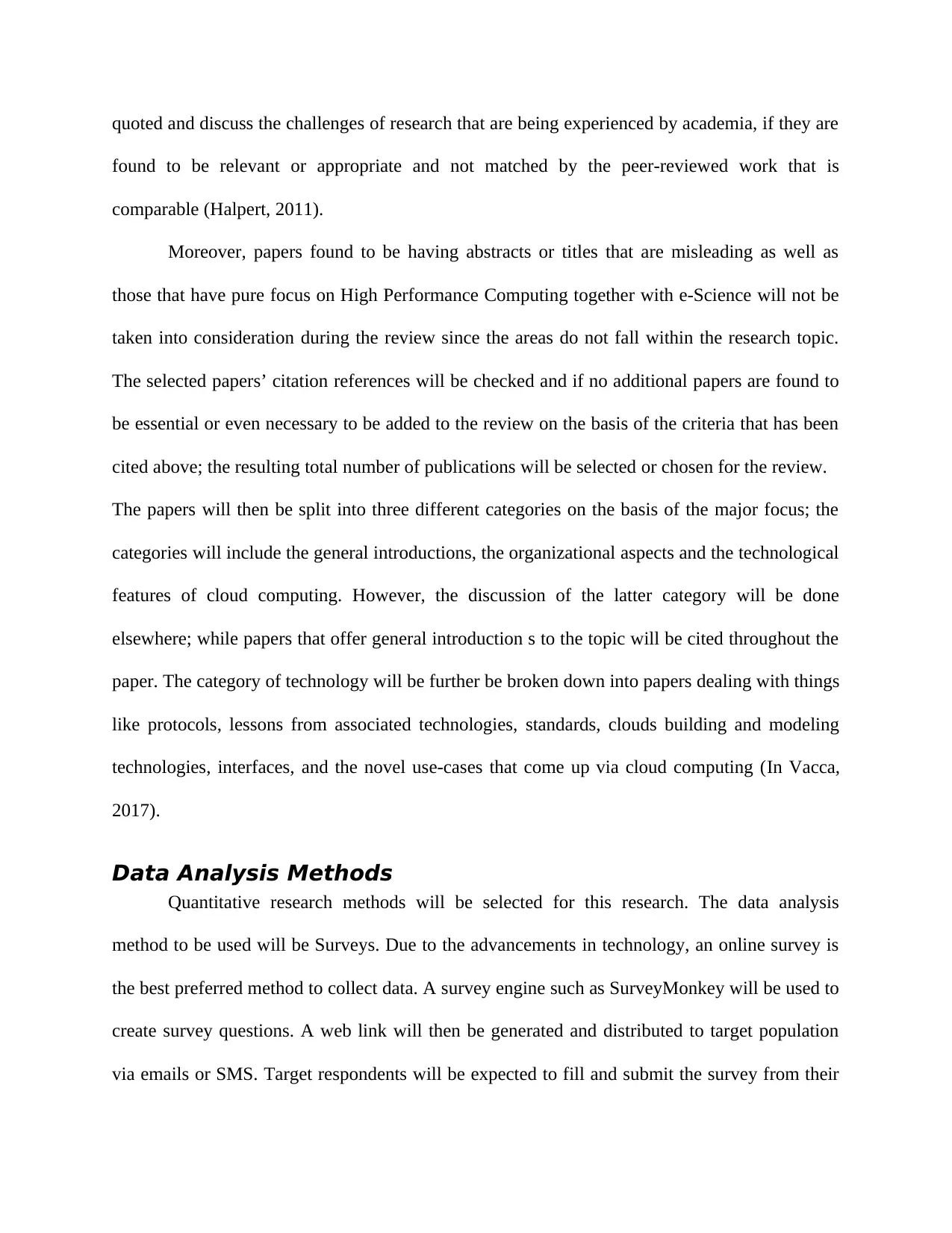
quoted and discuss the challenges of research that are being experienced by academia, if they are
found to be relevant or appropriate and not matched by the peer-reviewed work that is
comparable (Halpert, 2011).
Moreover, papers found to be having abstracts or titles that are misleading as well as
those that have pure focus on High Performance Computing together with e-Science will not be
taken into consideration during the review since the areas do not fall within the research topic.
The selected papers’ citation references will be checked and if no additional papers are found to
be essential or even necessary to be added to the review on the basis of the criteria that has been
cited above; the resulting total number of publications will be selected or chosen for the review.
The papers will then be split into three different categories on the basis of the major focus; the
categories will include the general introductions, the organizational aspects and the technological
features of cloud computing. However, the discussion of the latter category will be done
elsewhere; while papers that offer general introduction s to the topic will be cited throughout the
paper. The category of technology will be further be broken down into papers dealing with things
like protocols, lessons from associated technologies, standards, clouds building and modeling
technologies, interfaces, and the novel use-cases that come up via cloud computing (In Vacca,
2017).
Data Analysis Methods
Quantitative research methods will be selected for this research. The data analysis
method to be used will be Surveys. Due to the advancements in technology, an online survey is
the best preferred method to collect data. A survey engine such as SurveyMonkey will be used to
create survey questions. A web link will then be generated and distributed to target population
via emails or SMS. Target respondents will be expected to fill and submit the survey from their
found to be relevant or appropriate and not matched by the peer-reviewed work that is
comparable (Halpert, 2011).
Moreover, papers found to be having abstracts or titles that are misleading as well as
those that have pure focus on High Performance Computing together with e-Science will not be
taken into consideration during the review since the areas do not fall within the research topic.
The selected papers’ citation references will be checked and if no additional papers are found to
be essential or even necessary to be added to the review on the basis of the criteria that has been
cited above; the resulting total number of publications will be selected or chosen for the review.
The papers will then be split into three different categories on the basis of the major focus; the
categories will include the general introductions, the organizational aspects and the technological
features of cloud computing. However, the discussion of the latter category will be done
elsewhere; while papers that offer general introduction s to the topic will be cited throughout the
paper. The category of technology will be further be broken down into papers dealing with things
like protocols, lessons from associated technologies, standards, clouds building and modeling
technologies, interfaces, and the novel use-cases that come up via cloud computing (In Vacca,
2017).
Data Analysis Methods
Quantitative research methods will be selected for this research. The data analysis
method to be used will be Surveys. Due to the advancements in technology, an online survey is
the best preferred method to collect data. A survey engine such as SurveyMonkey will be used to
create survey questions. A web link will then be generated and distributed to target population
via emails or SMS. Target respondents will be expected to fill and submit the survey from their
⊘ This is a preview!⊘
Do you want full access?
Subscribe today to unlock all pages.

Trusted by 1+ million students worldwide
1 out of 16
Related Documents
Your All-in-One AI-Powered Toolkit for Academic Success.
+13062052269
info@desklib.com
Available 24*7 on WhatsApp / Email
![[object Object]](/_next/static/media/star-bottom.7253800d.svg)
Unlock your academic potential
Copyright © 2020–2025 A2Z Services. All Rights Reserved. Developed and managed by ZUCOL.




